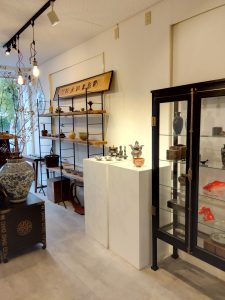今日は愛知県民の日です(愛知県名古屋市千種区姫池通 骨董買取 古美術風光舎)
2023.11.24
みなさまこんにちは。スタッフTでございます。
本日、この辺りの学校はお休みのようでございます。なぜなら、 愛知県が、県政150周年を記念して、今年から11月27日を「あいち県民の日」とすることなったからです。公立学校では「県民の日学校ホリデー」が実施され、11月21日から27日までの「あいちウィーク」の中で平日が1日お休みになりました。「あいちウィーク」には、親子で楽しめるイベントが行われたり、美術館や博物館などの公共施設の入場料が割引になったりするようですよ。

愛知県は今年から「県民の日」がスタートしたわけですが、「県民の日」や「都民の日」は、各都道府県が条例などで定めた記念日。必ずしも47都道府県すべてにあるわけではなく、現在制定されているのは愛知県を含め、19都道府県なんだそうです。郷土の歴史や文化を見つめ直し、郷土に対する理解と関心を深め、ふるさとを愛する心を育むことなどを目的として制定されているようです。
せっかくなので、県民らしく、愛知県について調べてみました。
愛知県は、律令体制以前は、尾張(木曽川・庄内川地方)、三河(西三河の矢作川地方)、穂(東三河の豊川地方)の3地域に分かれていましたが、律令制下では、尾張・三河の2国となり、江戸時代まで続きました。
明治4(1871)年の廃藩置県の後、12県(名古屋県・西尾県・岡崎県・豊橋県・犬山県・重原県・刈谷県・挙母県・半原県・西端県・田原県・西大平県)が置かれ、同年11月に尾張(知多郡を除く)は名古屋県に、三河と尾張の知多郡は額田県となり、明治5(1872)年4月に名古屋県は愛知県と改められ、同年11月27日に額田県を廃して愛知県の管轄に移し、永く続いた尾張国、三河国は愛知県として統合されました。
当時、県内には2,900を超える町や村がありましたが、明治の大合併、昭和の大合併を経て、昭和45(1970)年には市町村数は88となりました。その後30年以上、市町村数に変動はありませんでしたが、平成の合併により平成15(2003)年以降、新たに19件の市町村合併があり、市町村数は54(38市14町2村)となっています。
「あいち」の地名の由来は、万葉集巻三の高市黒人の歌「桜田へ鶴鳴き渡る年魚市潟(あゆちがた)潮干にけらし鶴鳴き渡る」に詠まれている、「年魚市潟(あゆちがた)」の「あゆち」が「あいち」に転じたと言われています。
廃藩置県後、県庁が愛知郡の名古屋城内に置かれたところから県名に採用されました。
県の花は「カキツバタ」、県の木は「ハナノキ」。「ハナノキ」は愛知県を中心とした中部地方にのみ自生するムクロジ科の落葉樹です。北設楽郡豊根村の茶臼山山麓にある「川宇連ハナノキ自生地」は、国の天然記念物に指定されています。(内容を愛知県HPより引用しています)
「県民の日」は新しい場所に行くきっかけになり、新しい発見につながるかもしれませんね。
ではでは、また
Hello everyone. This is Staff T.
It seems that schools around here are closed today. This is because Aichi Prefecture has designated November 27th as “Aichi Prefectural Citizens’ Day” to commemorate the 150th anniversary of the prefectural government. Public schools will have one weekday off during “Aichi Week” from November 21 to 27. During “Aichi Week,” there will be events for parents and children to enjoy together, and admission fees to museums and other public facilities will be discounted.
Aichi Prefecture started “Prefectural Citizens’ Day” this year, but “Prefectural Citizens’ Day” and “Metropolitan Citizens’ Day” are commemorative days set by each prefecture by ordinance. Not all 47 prefectures have such days, but currently 19 prefectures, including Aichi Prefecture, have established them. The purpose of this day is to review the history and culture of the hometown, to deepen understanding and interest in the hometown, and to nurture a love for the hometown.
Since I am a resident of the prefecture, I looked up Aichi Prefecture.
Before the Ritsuryo system, Aichi Prefecture was divided into three regions: Owari (Kiso River and Shonai River regions), Mikawa (Yahagigawa River region in West Mikawa), and Hoto (Toyokawa region in East Mikawa), but under the Ritsuryo system, it became two provinces, Owari and Mikawa, which continued until the Edo period.
After the abolition of feudal domains in 1871, 12 prefectures (Nagoya, Nishio, Okazaki, Toyohashi, Inuyama, Shigehara, Kariya, Katemo, Hanbara, Nishibata, Tahara, and Nishi Ohira) were established, and in November of the same year Owari (excluding Chita County) became Nagoya Prefecture, while Mikawa and Owari’s Chita County became Nukata Prefecture, and in April 1872 In April 1872, Nagoya Prefecture was renamed Aichi Prefecture, and on November 27 of the same year, Nukata Prefecture was abolished and transferred to the jurisdiction of Aichi Prefecture, and the long-standing provinces of Owari and Mikawa were consolidated as Aichi Prefecture.
At that time, there were more than 2,900 towns and villages in the prefecture, but after the great mergers of the Meiji and Showa periods, the number of municipalities reached 88 in 1970. The number of municipalities remained unchanged for more than 30 years, but since 2003, there have been 19 new mergers, bringing the total number of municipalities to 54 (38 cities, 14 towns, and 2 villages).
The name “Aichi” is said to have originated from a poem written by Koichi Kuroshi in the Manyoshu (The Anthology of Myriad Leaves), scroll 3, titled “Sakurada echidashi ni kerashi kakuwari (Cranes cawing in the Sakurada),” in which “Ayuchi” in “Nen-oichi-gata” was changed to “Aichi”.
After the abolition of feudal domains, the prefectural office was located in Nagoya Castle in Aichi County, and the name was adopted for the prefecture.
The prefectural flower is the kakitsubata, and the prefectural tree is the hananoki. The “Hananoki” is a deciduous tree of the Mukuroji family that grows naturally only in the Chubu region centering on Aichi Prefecture. The “Kawauren Hananoki Autonomous Area” located at the foot of Mt. Chausu in Toyone-mura, Kitashitara-gun, is designated as a national natural monument. (Quoted from the Aichi Prefecture website)
Prefectural Citizens’ Day may be a good opportunity to visit new places and make new discoveries.
See you soon!
*******************
ご実家の整理やお片付けなどをされている方のご相談などが多くございます。
お片付けなどくれぐれもご無理のないようになさってくださいませ。
風光舎では古美術品や骨董品の他にも絵画や宝石、趣味のお品など様々なジャンルのものを買受しております。
お片付けをされていて、こういうものでもいいのかしらと迷われているものでも、どうぞお気軽にご相談下さいませ。
また風光舎は、出張買取も強化しております。ご近所はもちろん、愛知県内、岐阜県、三重県その他の県へも出張いたします。
まずは、お電話お待ちしております。
愛知県名古屋市千種区姫池通
骨董 買取【古美術 風光舎 名古屋店】
TEL052(734)8444
10:00-17:00 OPEN
#出張買取#骨董#古美術#骨董品#絵画#版画#茶道具#刀剣#彫刻

